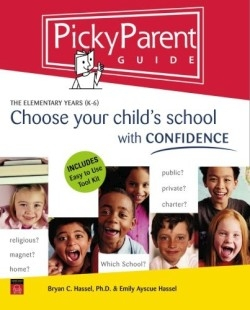Picky Parent Guide
Choose Your Child's School With Confidence
In the old days, choosing a child’s school was easy: the child simply went to the closest public school, or to a private, religion-based school. But today’s parents have a vast array of options available to them: open enrollment, charter, magnet, single-sex, boarding, public, private, religious, secular, and home schools. How can parents educate themselves on the options and decide which is best for their elementary child?
This book puts assistance at parents’ fingertips. The authors, who have first-hand knowledge of school selection for their own two children, are co-directors of Public Impact, an education policy and management consulting firm in North Carolina. Their work for the firm has brought them in contact with educational leaders across the U.S., and has provided information to other parents regarding school choices.
The Hassels’ personal and professional experience combined give this book its credibility and confidence, as the lead parents through a series of criteria, including the child’s needs (in terms of learning styles and social and practical needs), the family’s needs, and the options available to fill those needs. Each chapter in this practical workbook opens with a “Lightning List” that summarizes the chapter’s content, followed by an explanatory ending with “Snap To It” action checklists and worksheets for parents to make notes and brainstorm.
The authors use a conversational writing style that makes the highly informative text easier to absorb. They are also unafraid to point out what they perceive as flawed public information. For instance, in the chapter titled “What Really Separates the Best from the Rest?” they write: “Some research indicates that children learn more in small schools. Most likely, it is easier for those school leaders… to get everyone, staff and students, moving in the same direction in a smaller school. But a smaller school is neither required for… nor a guarantee of academic excellence.”
This type of thinking goes against traditional academic standards, as do the comments on class size and school year length. For parents struggling with a large variety of factors, the inclusion of different theories offers more resources with which to evaluate potential schools.
Although the length of the book may seem daunting, its workbook approach makes it user-friendly. The chapters are self-contained, but parents will especially benefit from working from the beginning in order to best understand the multiple factors involved in making this all-important decision. The Hassels have done an admirable job of taking a time-consuming and frustrating task and making it manageable for parents everywhere.
Reviewed by
Amy Rea
Disclosure: This article is not an endorsement, but a review. The publisher of this book provided free copies of the book to have their book reviewed by a professional reviewer. No fee was paid by the publisher for this review. Foreword Reviews only recommends books that we love. Foreword Magazine, Inc. is disclosing this in accordance with the Federal Trade Commission’s 16 CFR, Part 255.

